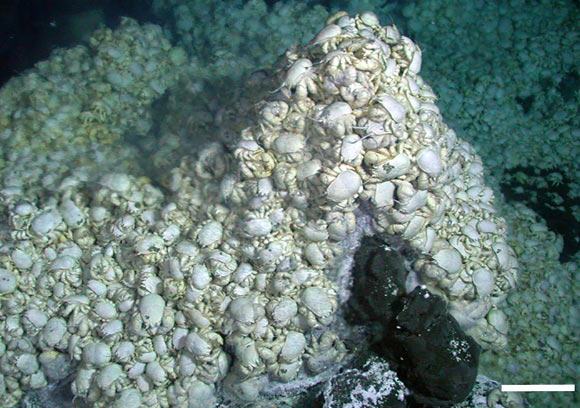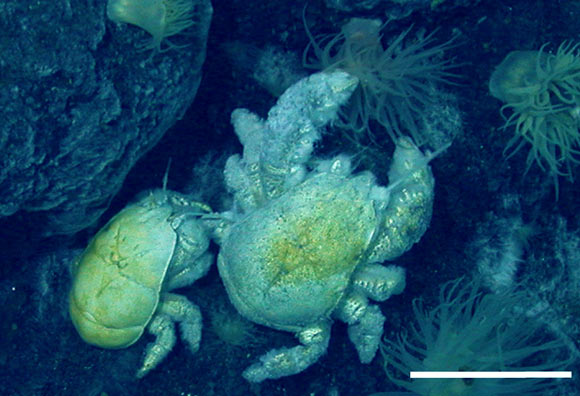Marine biologists from British Antarctic Survey and the University of Southampton, UK, have described the first species of yeti crab known from the Southern Ocean, Antarctica.
The new species, scientifically named Kiwa tyleri, belongs to Kiwaidae – an enigmatic group of squat lobsters that live in the hot waters surrounding the geothermally heated hydrothermal vents.
The group currently consists of three known species – Kiwa puravida, Kiwa hirsuta, and Kiwa tyleri, of which the new species is the only known representative in the Southern Ocean. Kiwa puravida was found at cold seep in the deep sea off Costa Rica, and Kiwa hirsuta from the periphery of deep-sea hydrothermal vents on the Pacific-Antarctic Ridge.
Kiwa tyleri is known from two vent sites situated on the northern and southern segments of the East Scotia Ridge in the Southern Ocean. It is the dominant species at the sites occurring at high densities, exceeding 700 specimens per m2.
“The three known species of Kiwaidae, including Kiwa tyleri, are of deep-sea occurrence (1,000 to 2,400 m), and are clearly associated with chemosynthetic environments. Kiwa puravida and Kiwa hirsuta occur in low-density aggregations of few specimens per m2, whereas Kiwa tyleri presents densely packed aggregations exceeding 700 individuals per m2, with a maximum observed abundance of 4,017 individuals per m2,” the scientists wrote in a paper published in the journal PLoS ONE.
Kiwa tyleri is notable for its body, which is densely covered by bristles and bacteria, giving it a fur-like outer appearance. This appearance is advantageous as it allows the animal to harvest the dense bacterial mats that overgrow the surfaces of vent chimneys, which it depends on for food from chemosynthetic bacteria.
For most of its life, Kiwa tyleri is trapped within the warm water environment of the vent chimney – up to about 77 degrees Fahrenheit (25 degrees Celsius) – and is unable move between vent sites because of the low temperature – about 32 degrees Fahrenheit (zero degrees Celsius), polar environment in between.
Female Kiwa tyleri carrying eggs only move away from vent chimneys, and into the surrounding polar deep-sea, in order to release their larvae; these would otherwise not survive the warmer temperatures of the adult habitat.
“The Antarctic Yeti Crab is trapped in its warm-water hydrothermal vent site by the cold polar waters of the surrounding deep-sea,” said Dr Sven Thatje of the University of Southampton, who is the lead author on the PLoS ONE paper.
“The species has adapted to this very limited sized habitat – of a few m3 in volume – by living in highly-packed densities and by relying on bacteria they grow on their fur-like setae for nutrition.”
Kiwa tyleri is named after the British deep-sea and polar biologist Prof Paul Tyler from the University of Southampton.
_____
Thatje S et al. 2015. Adaptations to Hydrothermal Vent Life in Kiwa tyleri, a New Species of Yeti Crab from the East Scotia Ridge, Antarctica. PLoS ONE 10 (6): e0127621; doi: 10.1371/journal.pone.0127621









